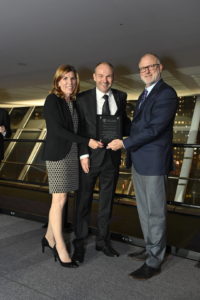November 8, 2021

Members of the CooperVision team (Deborah Jones and Paul Chamberlain) accepted the Garland M. Clay Award from Michael D. Twa, (right) at the AAO Meeting in Boston.
SAN RAMON, Calif. — A group of researchers involved in the study testing the efficacy of CooperVision’s MiSight 1 day contact lenses on myopia progression†1 was awarded the American Academy of Optometry’s (AAO) Garland W. Clay Award.
The prestigious award is given annually to the author(s) of the most important paper published in Optometry and Vision Science in the preceding five years. The authors of the winning paper, “A 3-Year Randomized Clinical Trial of MiSight Lenses for Myopia Control,” include: Paul Chamberlain, BSc (Hons.); Sofia C. Peixoto-De-Matos, MSc; Nicola S. Logan, PhD; Cheryl Ngo, MBBS, MMed; Deborah Jones, BSc, FAAO; and Graeme Young, PhD, FAAO.
“Our team is grateful to the Optometry and Vision Science Editorial Board and the American Academy of Optometry for recognizing our work,” said Paul Chamberlain, BSc (Hons.), Director of Research Programs at CooperVision. “It is very satisfying to know that our research in myopia control is helping age-appropriate children and their parents around the world. And it is truly an honor to be associated with the other pioneering papers that have previously received this distinction.”
The Optometry and Vision Science editorial board bestows the annual Garland W. Clay Award based upon criteria including the number of citations in the world scientific literature, impact of vision science, value to the practice of optometry, and relevance to the mission of the American Academy of Optometry. After only two years since publication, the paper about MiSight 1 day contact lenses has been cited over 70 times according to Clarivate’s Web of Science and is the most cited paper in Optometry and Vision Science since 2016.
“Clinical trial results provide strong evidence that it is possible to slow ocular growth that causes worsening myopia,” said Michael Twa, OD, PhD, FAAO, Editor-in-Chief of Optometry and Vision Science. “Research into myopia control is rapidly evolving, and effective treatments could do more than improve vision. They may also help lower lifelong risks for glaucoma, retinal detachments, and other degenerative eye conditions.”2
The full paper is available online via OpenAccess.
*U.S. Indications for use: MiSight® 1 day (omafilcon A) soft (hydrophilic) contact lenses for daily wear are indicated for the correction of myopic ametropia and for slowing the progression of myopia in children with non-diseased eyes, who at the initiation of treatment are 8-12 years of age and have a refraction of -0.75 to -4.00 diopters (spherical equivalent) with ≤ 0.75 diopters of astigmatism. The lens is to be discarded after each removal.
References
†Compared to a single vision 1 day lens.
1 Chamberlain P, et al. A 3-year randomized clinical trial of MiSight® lenses for myopia control. Optom Vis Sci. 2019; 96(8):556-567.
2 Flitcroft DI. The complex interactions of retinal, optical and environmental factors in myopia aetiology. Prog Retin Eye Res. 2012;31:622-60.













